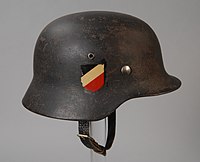
Photo from wikipedia
ABSTRACT Objectives: This study aimed to determine the factors associated with the incorrect use of a helmet retention system (loose or open) and how often this happens. Methods: This was… Click to show full abstract
ABSTRACT Objectives: This study aimed to determine the factors associated with the incorrect use of a helmet retention system (loose or open) and how often this happens. Methods: This was an observational transversal study conducted in Curitiba, Brazil. Trained observers positioned at traffic lights collected information about the helmet fixation mode, the helmet model (full-face, open-face, modular, half), and the helmet retention system model (micrometric, double-D, fast-release). Additional data including position on the motorcycle, gender, and function of the motorcycle (as a work vehicle) were collected. The observers, collection site, and periods were randomly selected by lots. Results: From a total of 3,050 motorcyclists, 1,807 (59.2%) had their helmets fastened correctly, 907 (29.7%) had the retention system fastened loosely, and in 336 (11.0%), the retention system was completely open. Increased odds of incorrect use were observed for the fast-release and double-D buckles compared to the micrometrics buckles, with a fixed odds ratio (OR) of 4.62 (95% confidence interval [CI], 3.89–5.51) and 3.54 (95% CI, 2.46–5.09), respectively (P <.0001). Full-face helmets had a higher chance of incorrect use (P <.0001), and passengers had a higher incidence of incorrect use of the helmet than drivers (P <.0001). Conclusion: An important risk factor related to the incorrect use of the helmet was the type of retention system. The helmet model and being a passenger had a secondary influence on incorrect use of helmets.
Journal Title: Traffic Injury Prevention
Year Published: 2018
Link to full text (if available)
Share on Social Media: Sign Up to like & get
recommendations!